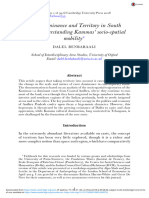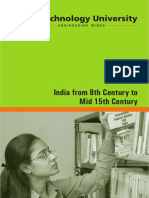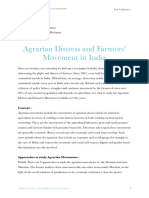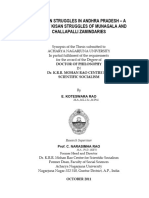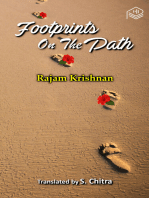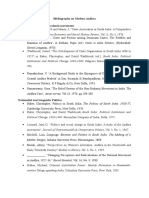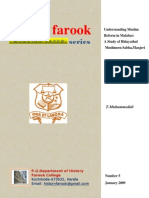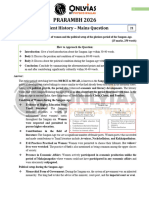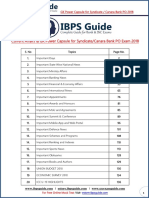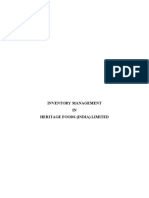Dominant Caste and Territory in South in PDF
Dominant Caste and Territory in South in PDF
Uploaded by
Santhosh TekumalCopyright:
Available Formats
Dominant Caste and Territory in South in PDF
Dominant Caste and Territory in South in PDF
Uploaded by
Santhosh TekumalOriginal Title
Copyright
Available Formats
Share this document
Did you find this document useful?
Is this content inappropriate?
Copyright:
Available Formats
Dominant Caste and Territory in South in PDF
Dominant Caste and Territory in South in PDF
Uploaded by
Santhosh TekumalCopyright:
Available Formats
Dominant Caste and Territory in South India:
Migration and Upward Social Mobility of the Kammas from Coastal Andhra
Dalel BENBABAALI
Abstract: This thesis aims at redefining the concept of dominant caste which was first studied
at the village level, in the context of 1950s rural India, to make it relevant by adapting it to the
contemporary evolutions of a rapidly urbanising country, where social and spatial mobility is
increasing. With this objective in mind, this research explores the case of Kammas, a
dominant caste from Coastal Andhra where they continue to control most of the land, even
though they have migrated in large numbers towards the interior and southern regions of the
Indian peninsula, both to newly irrigated areas and to the cities. They now occupy key
positions in politics and in the economy of Andhra Pradesh, and to a lesser extent of Tamil
Nadu and Karnataka. Taking territory into account, a concept which was developed in Social
Geography, is essential to understand this change in the scale and nature of caste dominance
and to study its regional variations. In the 1980s, when the Kamma-dominated Telugu Desam
Party won the elections in Andhra Pradesh, their control over State power helped them
consolidate their influence. They also dominate the Telugu media and cinema, which confers
upon them sociocultural preeminence. These new attributes of dominance, which are
ideological and not only material, have a hegemonic character. However, this hegemony is
threatened by the growing resistance of Dalits to caste and class oppression, while Kamma
cultural domination is contested in the Telangana region by those supporting the creation of a
State separated from Andhra.
INTRODUCTION
Justification of the selected topic
Definition of concepts
Research question
Methodology
Structure of the thesis
Part I - Caste dominance: a research topic in geography?
Chapter 1. Territory, a neglected notion in caste studies by social scientists
I. Village versus caste: the terms of the controversy on the proper unit of study
1. Dumonts position on territory and its critique
2. The absence of territory in India: archeology of a stereotype
II. Village studies: territory as a mere frame for the analysis of caste relations
1. The village as community: an idealised vision
2. The jajmani system: myth and reality
III. Caste studies: an uneven treatment of the territorial dimension
1. The varna pan-Indian system versus the jati territorialised system
2. The place of territory in caste monographies
1
Chapter 2. Territoriality of the dominant caste: the contributions of social geography
I. The dominant caste defined through territory
1. An African origin
2. A concept progressively enriched by Srinivas
3. The criticism of the concept
4. Rehabilitation of the concept
II. Socio-spatial mobility of the elites: specific forms
1. Elite studies versus subaltern studies
2. Prevalence of poverty in migration studies
3. When migration and prosperity go hand in hand: socioprofessional mobility of rural
elites
III. The geographical concepts of territory and territoriality applied to a caste society
1 Social geography and territory: how relevant in the Indian context?
2. Territoriality of the dominant as a strategy of control: for a geography of power
3. Caste hegemony: towards a deterritorialisation of dominance?
Part II - Emergence of Kammas as a dominant caste and territorial control
Chapter 3. A mobile peasant-warrior caste in the medieval period
I. Kammas traditional territory: from the Krishna-Godavari delta to the Penner
1. A caste named after a territory: Kamma rashtra and Kammanadu
2. A territory of humid plains and fertile deltas
II. Military migrations under the Vijayanagar empire: the conquest of the Tamil country
1. War of conquest as a migration factor
2. Agricultural activities on conquered lands
III. Movements of agricultural colonisation to the Deccan Plateau: land acquisitions in
Telangana under Muslim rule
1. The Deccan: a semi-arid plateau under Muslim control
2. Kammas agricultural migrations towards Telangana
Chapter 4. An agrarian caste that benefitted from development in Coastal Andhra
under the British rule
I. Agrarian and regional development in Andhra
1. Land tenure systems, revenue policy and introduction of canal irrigation in Coastal
Andhra
2. Development of communication infrastructures and commercialisation of agriculture
3. Urban growth and industrialisation
II. Kammas upward social mobility, from class differenciation to caste unity
1. Emergence of a class of Kulaks
2. Birth of Kamma caste associations, efforts at unification and collective mobility
3. Political organisation and evolution of Kammas position vis--vis British rule
2
Chapter 5. Territorial expansion and rise of Kammas since Independence
I. Territorial recompositions and Kamma migrations
1. Kammas participation in the Telangana rebellion (1946-51)
2. Telugu regionalism and formation of a separate Andhra province
3. Creation of Andhra Pradesh and intensification of migrations to the interior regions
II. Economic diversification and Kammas access to political power at the State level
1. A caste that benefitted from agrarian reforms and the Green Revolution
2. The formation of the Telugu Desam Party and the election of N.T. Rama Rao, first
Kamma Chief Minister of Andhra Pradesh (1983-89)
3. Kammas upward mobility since the economic reforms under Chandrababu Naidu
regime (1995-2004)
Part III - Regional variations in territorial expression of caste dominance
Chapter 6. Kamma territorialities: degrees of rural and urban dominance in three
South Indian States
I. A comparative study of Kammas in Kukatpally (Hyderabad) and in Godavarru village
(Krishna district)
1. Presentation of the urban and rural quantitative surveys through questionnaires
2. Migration profiles, educational levels, family structures
3. Professional mobility, economic position, social and political participation
II. Kamma dominance in urban areas: a comparative study of two regional metropolises,
Vijayawada (Andhra Pradesh) and Coimbatore (Tamil Nadu)
1. Presentation of the qualitative survey through interviews
2. Two regional metropolises dominated by the same caste
3. Differences in the nature of Kamma dominance in Vijayawada and Coimbatore
III. Kamma dominance in areas of agricultural colonisation: a comparative study of two
irrigated zones of the Deccan, in Karnataka (Tungabhadra project) and in Telangana (Sriram
Sagar project, Nizamabad)
1. Presentation of the fieldwork
2. The migrants of development in the Tungabhadra irrigated belt: teaching paddy
cultivation to the locals
3. Inner colonisation of Telangana: turning the desert green
Chapter 7. Mobilisation of lower castes and the Telangana regionalist movement:
towards a decline of Kamma dominance?
I. The Dalit movement in Coastal Andhra, a consequence of Kamma oppression
1. Methodological problems of perpetrator-oriented studies
2. The Karamchedu massacre and Dalit mobilisation
3. Interpretations
II. Kammas as targets of naxalism and regionalism in Telangana
1. Naxalism in Andhra Pradesh and its repression
2. The separate Telangana movement: a struggle against dominant castes ?
3
You might also like
- Policies and Programmes of Telugu Desam Party: Chapter - 6Document49 pagesPolicies and Programmes of Telugu Desam Party: Chapter - 6Nafees ShaikNo ratings yet
- Sumit Sarkar, Tanika Sarkar - Caste in Modern India - A Reader (2014, Permanent Black)Document1,177 pagesSumit Sarkar, Tanika Sarkar - Caste in Modern India - A Reader (2014, Permanent Black)Dhruv Aryan KundraNo ratings yet
- Kamma Caste Full PaperDocument39 pagesKamma Caste Full Paperkrishnaravuri113No ratings yet
- Princeton Talk On Kamma CasteDocument10 pagesPrinceton Talk On Kamma CasteP Venkata SureshNo ratings yet
- 12 - Chapter 3 PDFDocument44 pages12 - Chapter 3 PDFjayalakshmi sujithNo ratings yet
- Ans Key 2 HISTORY SUTRA DAY 2Document4 pagesAns Key 2 HISTORY SUTRA DAY 2rashmid2017No ratings yet
- Srinivas - Dominant CasteDocument17 pagesSrinivas - Dominant CastemailgawrieNo ratings yet
- Tamilnadu HistoryDocument374 pagesTamilnadu HistoryCHANDRU U100% (2)
- Unit 4 Village Studies in India NotesDocument12 pagesUnit 4 Village Studies in India Notesranjan81345No ratings yet
- Group1 SyllabusDocument9 pagesGroup1 Syllabusphani nagNo ratings yet
- 07 - Chapter 1 Mysore HistoryDocument29 pages07 - Chapter 1 Mysore Historyarunbabbur100% (1)
- The Complexities of Tribal Land Rights and Conflict in ManipurDocument24 pagesThe Complexities of Tribal Land Rights and Conflict in ManipurByomkesh BakshiNo ratings yet
- History Honours SyllabusDocument15 pagesHistory Honours SyllabusGulrez MNo ratings yet
- UGC NET History SyllabusDocument14 pagesUGC NET History Syllabuslukman12No ratings yet
- India From 8th Century To Mid 15th CenturyDocument449 pagesIndia From 8th Century To Mid 15th CenturyAnonymous PErKNy9No ratings yet
- 12 - Chapter 1Document80 pages12 - Chapter 1AnjaliNo ratings yet
- 08 - Chapter 1 PDFDocument39 pages08 - Chapter 1 PDFSona ANo ratings yet
- 06 - Chapter 1 PDFDocument39 pages06 - Chapter 1 PDFR.Sowmya Reddy100% (1)
- Clearias Com Medieval India TribesDocument3 pagesClearias Com Medieval India TribesSiddharth DvivediNo ratings yet
- Padmini Chapter5Document11 pagesPadmini Chapter5Gd MNo ratings yet
- Caste As Maratha Social Categories ColonDocument27 pagesCaste As Maratha Social Categories ColonArvind KolhatkarNo ratings yet
- Caste and Social Stratification in Medieval IndiaDocument225 pagesCaste and Social Stratification in Medieval IndiaAshwini Gupta100% (1)
- History Syllabus OptionalDocument4 pagesHistory Syllabus Optionaldummyem1234No ratings yet
- RavinderDocument9 pagesRavindervpsingh0100No ratings yet
- Bharathidasan University Tiruchirappalli 620 0Document21 pagesBharathidasan University Tiruchirappalli 620 0asdfghjklçNo ratings yet
- 11 Chapter 4Document33 pages11 Chapter 4OMSURYACHANDRANNo ratings yet
- Paper 2.3 - History of Ancient India Upto 1707 Ad Unit - IDocument95 pagesPaper 2.3 - History of Ancient India Upto 1707 Ad Unit - IUtkarsh SinghNo ratings yet
- Dalits in Telugu LandDocument5 pagesDalits in Telugu LandsivaramanlbNo ratings yet
- Medieval India Tribes Nomads and Settled CommunitiesDocument3 pagesMedieval India Tribes Nomads and Settled CommunitiessagarthegameNo ratings yet
- TSPSC Master Group 1 Mains Schedule For PreparationDocument9 pagesTSPSC Master Group 1 Mains Schedule For Preparationsantosh ReddyNo ratings yet
- Agrarian Movements - Karan SinghDocument10 pagesAgrarian Movements - Karan SinghMicky KharbandaNo ratings yet
- 05 Medieval India Tribes, Nomads and Settled Communities PDFDocument2 pages05 Medieval India Tribes, Nomads and Settled Communities PDFsarawalem1No ratings yet
- Village Community: Level, They Have Long Been Considered The Preserve of Social Anthropologists andDocument29 pagesVillage Community: Level, They Have Long Been Considered The Preserve of Social Anthropologists andVanshika YadavNo ratings yet
- HistDocument8 pagesHistSamrat Rick DeyNo ratings yet
- 2history Syllabus I II III IV Semesters CBCS New 2010Document81 pages2history Syllabus I II III IV Semesters CBCS New 2010Pratik KulkarniNo ratings yet
- SyllableDocument14 pagesSyllablesantoshkhade143No ratings yet
- The Kisan Struggles in Andhra Pradesh - A Study of Kisan Struggles of Munagala and Challapalli ZamindariesDocument14 pagesThe Kisan Struggles in Andhra Pradesh - A Study of Kisan Struggles of Munagala and Challapalli Zamindariesvejendlagopi1992No ratings yet
- Ashtavaidyas PDFDocument37 pagesAshtavaidyas PDFbharikrishnan17701No ratings yet
- Upsc Syllabus in DetailedDocument9 pagesUpsc Syllabus in DetailedvasuNo ratings yet
- A Separate TelanganaDocument5 pagesA Separate TelanganaParth PatelNo ratings yet
- Gods, Groves and The Culture of Nature in Kerala FreemanDocument46 pagesGods, Groves and The Culture of Nature in Kerala FreemanTori SheldonNo ratings yet
- Core 3Document182 pagesCore 3chandhu anil kumarNo ratings yet
- SOC1C04Document145 pagesSOC1C04Ananta ChaliseNo ratings yet
- Caste System Under CholasDocument46 pagesCaste System Under CholasKishore Kumar100% (1)
- THECŌL A STATE FinalDocument7 pagesTHECŌL A STATE FinalPrachetas KushwahaNo ratings yet
- Bibliography On Modern AndhraDocument5 pagesBibliography On Modern AndhraChandra BhanuNo ratings yet
- Diverse Meanings of Freedom Struggle in South Asia-862Document7 pagesDiverse Meanings of Freedom Struggle in South Asia-862Abdur Rehman AliNo ratings yet
- Understanding Muslim Reform in Malabar: A Study of Hidayathul Muslimeen Sabha, ManjeriDocument17 pagesUnderstanding Muslim Reform in Malabar: A Study of Hidayathul Muslimeen Sabha, Manjerihodhistory100% (1)
- Manipur HistoryDocument46 pagesManipur HistoryHadee SaberNo ratings yet
- Ancient History 21 - Mains Question - UPSC Prarambh 2026Document2 pagesAncient History 21 - Mains Question - UPSC Prarambh 2026lokeshk88825No ratings yet
- Peasants Armed StruggleDocument7 pagesPeasants Armed StrugglevamshidoneparthiNo ratings yet
- Historical StudiesDocument16 pagesHistorical StudiesVijayalakshmi .SNo ratings yet
- Book Edcoll 9789047420620 Bej.9789004160347.i-331 006-PreviewDocument2 pagesBook Edcoll 9789047420620 Bej.9789004160347.i-331 006-PreviewEnnoNo ratings yet
- 1516353477P11 M20 SocietyandCultureintheSangamAge ETDocument14 pages1516353477P11 M20 SocietyandCultureintheSangamAge ETnexusforbusiness7No ratings yet
- Understanding The Hills-Valley Divide and Meitei-Kuki Conflict in ManipurDocument24 pagesUnderstanding The Hills-Valley Divide and Meitei-Kuki Conflict in ManipurThangpi NaulakNo ratings yet
- His Optional Syllabus (WBCS)Document5 pagesHis Optional Syllabus (WBCS)RakeshNo ratings yet
- Lizy PP - Tribes of Wayanad in Transition From A D 1947 To 2006Document242 pagesLizy PP - Tribes of Wayanad in Transition From A D 1947 To 2006sreenathpnrNo ratings yet
- Escape ArgicultureDocument34 pagesEscape ArgicultureJNo ratings yet
- Group 1 PlanDocument10 pagesGroup 1 PlanSunnyNo ratings yet
- Calibrated Engagement: Chronicles of Local Politics in the Heartland of MyanmarFrom EverandCalibrated Engagement: Chronicles of Local Politics in the Heartland of MyanmarNo ratings yet
- Protocol For Village Human Developmentplans in TelanganaDocument6 pagesProtocol For Village Human Developmentplans in TelanganaSanthosh TekumalNo ratings yet
- A Subaltern View of Climate ChangeDocument9 pagesA Subaltern View of Climate ChangeSanthosh TekumalNo ratings yet
- Research Proposal On Denotified TribesDocument6 pagesResearch Proposal On Denotified TribesSanthosh TekumalNo ratings yet
- Social Exclusion Caste Health - A Review Based On The SocialDocument9 pagesSocial Exclusion Caste Health - A Review Based On The SocialSanthosh TekumalNo ratings yet
- Loksatta Party Candidates Telangana - 2014Document2 pagesLoksatta Party Candidates Telangana - 2014Santhosh TekumalNo ratings yet
- Win XP KeyDocument1 pageWin XP KeySanthosh TekumalNo ratings yet
- The 8051 Assembly LanguageDocument89 pagesThe 8051 Assembly LanguageSanthosh TekumalNo ratings yet
- Chiru Praja Rajyam Party ManifestoDocument54 pagesChiru Praja Rajyam Party Manifestoyvsr2003100% (1)
- 2-List of Successful CandidatesDocument5 pages2-List of Successful CandidatesShashank RNo ratings yet
- WCM VbeDocument59 pagesWCM VbeMohmmedKhayyumNo ratings yet
- Intelligence Bureau Election Survey ReportDocument219 pagesIntelligence Bureau Election Survey Reportdilawarsd58No ratings yet
- DR G Samaram CVDocument15 pagesDR G Samaram CVjamalapurapu rajeswara raoNo ratings yet
- Current Affairs November 2016 Quiz PDFDocument62 pagesCurrent Affairs November 2016 Quiz PDFAritraRionKunduNo ratings yet
- Politics-Policy-Bala Raju Nikku - Thesis-Wageningen-2006Document302 pagesPolitics-Policy-Bala Raju Nikku - Thesis-Wageningen-2006nikku211100% (4)
- Chandrababu NaiduDocument2 pagesChandrababu NaiduprataporugantiNo ratings yet
- Aparchit June 3rd Week English Best 350+ MCQs With Amazing FactsDocument120 pagesAparchit June 3rd Week English Best 350+ MCQs With Amazing FactsPankaj AmariaNo ratings yet
- Current Affairs & GK Power Capsule For Syndicate Bank PO Exam 2018 (PDFDrive)Document137 pagesCurrent Affairs & GK Power Capsule For Syndicate Bank PO Exam 2018 (PDFDrive)Dharmesh Kumar PrajapatiNo ratings yet
- Vijayawada DC 01-11-2023Document8 pagesVijayawada DC 01-11-2023sailajamv9No ratings yet
- Interview QuestionsDocument31 pagesInterview Questionspvineeth23mmsNo ratings yet
- RC - No.250 GE - 2024Document200 pagesRC - No.250 GE - 2024DCRB KURNOOLNo ratings yet
- AP ReorganisationDocument16 pagesAP ReorganisationabctandonNo ratings yet
- Change of Guard: Kovind Takes Over As PrezDocument16 pagesChange of Guard: Kovind Takes Over As PrezYRBABUNo ratings yet
- Andhra Pradesh (: de FactoDocument34 pagesAndhra Pradesh (: de Factoyellowseven archiectsNo ratings yet
- Current Affairs Q&A PDF June 14 2024 by Affairscloud 1Document21 pagesCurrent Affairs Q&A PDF June 14 2024 by Affairscloud 1zdbeiseikimaNo ratings yet
- Emperor of CorruptionDocument128 pagesEmperor of CorruptionRam CharanNo ratings yet
- June - 2024 Current Affairs For All SSC ExamsDocument308 pagesJune - 2024 Current Affairs For All SSC ExamsAditya KhestiNo ratings yet
- General Knowledge and Current Affairs PDFDocument137 pagesGeneral Knowledge and Current Affairs PDFSumit YadavNo ratings yet
- NTR PDFDocument19 pagesNTR PDFRajesh KondaveetiNo ratings yet
- A Girl From Vizag Wrote An Open Letter To CM Chandrababu Naidu. Interesting.! - South ReportDocument7 pagesA Girl From Vizag Wrote An Open Letter To CM Chandrababu Naidu. Interesting.! - South ReportharryhermionealbusNo ratings yet
- Andhra Pradesh Current Affairs - January 2018Document19 pagesAndhra Pradesh Current Affairs - January 2018Mohammed Javeed ahmedNo ratings yet
- JagranJosh CA Quiz Jun 2024Document56 pagesJagranJosh CA Quiz Jun 2024KaMaL KS DhArNo ratings yet
- 18 Vol 5 EpaperDocument78 pages18 Vol 5 EpaperVineet KumarNo ratings yet
- Inventory Management in Heritage Foods (India) LimitedDocument69 pagesInventory Management in Heritage Foods (India) LimitedNagaraju100% (1)
- N Chandrababu Naidu's Leadership in Transforming Andhra Pradesh Industrial LandscapeDocument2 pagesN Chandrababu Naidu's Leadership in Transforming Andhra Pradesh Industrial Landscapekuresu.seoNo ratings yet
- Ananthapur DC 08-07-2023Document8 pagesAnanthapur DC 08-07-2023cdnaveenNo ratings yet
- Annexu 218 250Document23 pagesAnnexu 218 250Sajja SrinivasNo ratings yet


